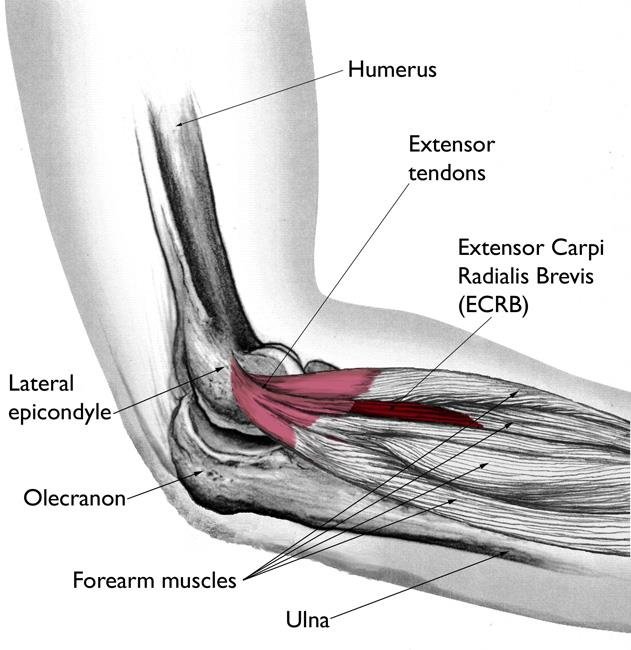
Lateral Epicondylitis
(Tennis Elbow)
Lateral Epicondylitis
Lateral epicondylitis, also known as “Tennis Elbow”, is a condition consisting of small tears in the muscles and tendons of the forearm that allow wrist extension from repetitive use. As a result of these small tears, pain and inflammation can develop at the lateral (outer) epicondyle, a bony prominence on the humerus (upper arm bone) on the outside of the elbow that serves as an attachment site for these tendons. As the name suggests, athletes that participate in tennis or other racket sports are at higher risk of developing epicondylitis. However, epicondylitis can occur from a work-induced injury seen in painters, butchers, plumbers, carpenters, and even gardeners.
Orthopedic Surgeon and Sports Medicine specialist, Dr. Jonathan Koscso, successfully diagnoses and treats patients in Sarasota, FL and the surrounding Gulf Coast region who are experiencing lateral epicondylitis.
Symptoms of Lateral Epicondylitis
The most common complaint of tennis elbow or lateral epicondylitis is tenderness and pain over the lateral epicondyle on the outside of the elbow. Other symptoms include:
A constant dull ache on the outside of the affected elbow
Radiating pain into the upper or lower arm
A weak grip making it difficult to turn a doorknob or hold a cup of coffee
Dr. Koscso can diagnose tennis elbow after performing a comprehensive medical history and physical examination. Some specific testing during the physical examination may include palpating over the lateral epicondyle of the affected elbow and straightening of the wrist and fingers against resistance. Diagnostic imaging, including x-rays and magnetic resonance imaging (MRI), may be requested to identify damage to any other structures within the elbow joint, rule out bone abnormalities, and check for torn or damaged tissue.
Non-Surgical Treatment
Lateral epicondylitis is most commonly treated successfully with non-surgical therapy alone. A combination of rest and oral non-steroidal anti-inflammatory medications (ibuprofen, naproxen, meloxicam, etc.) can significantly reduce pain symptoms while the injured tendon is healing. Ultimately, once pain is controlled, a guided physical therapy regimen is crucial to correcting shoulder and elbow muscle imbalances are regaining strength in the upper limb.
On occasion, particularly in patients with refractory symptoms despite the above interventions, an injection into the tendon may be offered to minimize pain and/or optimize healing of the injured tendon. There are a couple injection therapies that you may discuss with Dr. Koscso at your visit. These include:
Corticosteroid injection with the goal of reducing pain and inflammation so that ongoing physical therapy and strengthening of the elbow may be carried out.
Platelet-rich plasma injection with the aim of optimizing the healing environment around the injured tendon.
Both of these injection therapies carry slightly different aims and side effect profiles which can be discussed at your visit.
Surgical Treatment
For patients that experience more severe elbow pain, or when conservative therapy is unsuccessful, surgical repair of the injured tendons may be necessary. Dr. Koscso can repair the damaged tissue with a minimally invasive surgical method using a small incision made in the area of the damaged tendons. In this procedure, the portion of diseased tendon is removed (since it has exhausted its healing capacity) and the remaining healthy tendon is then reattached to the lateral epicondyle bone using small sutures and anchors. For patients who have not been relieved with the non-surgical interventions above, surgery has a high probability of restoring their desired elbow function.
Post-Operative Recovery
For a comprehensive reading of the expected post-operative recovery, including restrictions, physical therapy progressions, and return to work/sport guidelines after lateral epicondylitis surgery, please see our corresponding protocol on our physical therapy protocols page.
About the Author
Dr. Jonathan Koscso is an orthopedic surgeon and sports medicine specialist at Kennedy-White Orthopaedic Center in Sarasota, FL. Dr. Koscso treats a vast spectrum of sports conditions, including shoulder, elbow, knee, and ankle disorders. Dr. Koscso was educated at the University of South Florida and the USF Morsani College of Medicine, followed by orthopedic surgery residency at Washington University in St. Louis/Barnes-Jewish Hospital and sports medicine & shoulder surgery fellowship at the Hospital for Special Surgery in New York City, the consistent #1 orthopaedic hospital as ranked by U.S. News & World Report. He has been a team physician for the New York Mets, Iona College Athletics, and NYC’s PSAL.
Disclaimer: All materials presented on this website are the opinions of Dr. Jonathan Koscso and any guest writers, and should not be construed as medical advice. Each patient’s specific condition is different, and a comprehensive medical assessment requires a full medical history, physical exam, and review of diagnostic imaging. If you would like to seek the opinion of Dr. Jonathan Koscso for your specific case, we recommend contacting our office to make an appointment.




